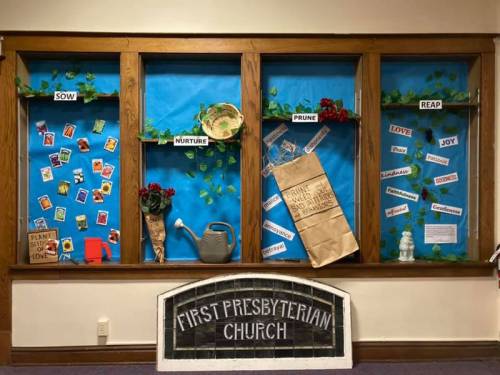Congregation reshapes its vision — and mission statement
By Donna Frischknecht Jackson | Presbyterians Today
Matthew 25 Focus: Building congregational vitality
Local Situation: A changing community means a change in vision.
 When the Rev. Dr. Christina Berry enrolled her congregation to become a Matthew 25 church, little did she know just how the Spirit would move among them. After reviewing the areas of focus that her flock could engage in — building congregational vitality, dismantling structural racism and eradicating systemic poverty — focusing on vitality made the most sense for an all-white congregation living in the shadow of glory days gone by.
When the Rev. Dr. Christina Berry enrolled her congregation to become a Matthew 25 church, little did she know just how the Spirit would move among them. After reviewing the areas of focus that her flock could engage in — building congregational vitality, dismantling structural racism and eradicating systemic poverty — focusing on vitality made the most sense for an all-white congregation living in the shadow of glory days gone by.
First Presbyterian Church of Sterling, Illinois, founded in 1844, once thrived thanks to the local steel mills. After a fire in 1922, the congregation rebuilt its current three-story structure, complete with a gym. The embarrassment of riches continued for a few more decades. Berry came across a capital campaign brochure from 1963 for a Christian Education wing that highlighted the “problem with growth.” “Children were swinging from the rafters,” she said. The steel industry, though, declined in the 1990s, leaving First Presbyterian with a cavernous building no longer ripping at the seams. “We now have 70 in worship on average,” said Berry.
While congregational vitality seemed like the thing First Presbyterian needed, Berry was clear that this was not about “getting butts in the pews.” The Matthew 25 work began a year before the pandemic shuttered church buildings in March 2020. Using the “Seven Marks of Congregational Vitality” from the PC(USA)’s Vital Congregations initiative, Berry began session meetings inviting elders to explore one mark and assess how they measured up. The discussions of hospitality revealed how the congregation was already on that path. Just a few years before, a gay man began attending the church. He was hesitant, though, to join. He met with the session and shared his faith journey. Berry recalled that there wasn’t a dry eye around the table. That moment was a shift for the congregation in redefining what it meant to be welcoming. The Christian Education wing built in 1963 was now opened to LGBTQ+ youth in the community.
Berry began seeing how focusing on congregational vitality was actually becoming a “Trojan horse,” leading the congregation to ministries of justice that they had not seen before. Their search for what it meant to be vital led to deepening their understanding of being hospitable, which led to broadening what being Presbyterian meant, which led to broadening who a Presbyterian is.
“We are now known as ‘that’ church,” Berry said with pride: “that” church, which welcomes the LGBTQ+ community; “that” church, which promotes antiracism awareness in the community — all because questions of vitality have led to questions of justice.
Another change Berry is seeing is a radical one, involving a church committee that is often the hardest to change: finance. However, it has been that committee, said Berry, who has aligned its mission statement with the work of Matthew 25. “They are no longer saying that they ‘protecting and maintaining the principal,’” Berry said, but rather, “they are now ‘managing the money that will support ministries.’”
“Matthew 25 is leading us to rewrite statements that are meant to guide us,” said Berry, mulling over what a revamped statement the congregation might say. Berry has in mind a paraphrase of a Talmudic saying, which is a commentary on Micah 6:8: “Do not be daunted by the enormity of the world’s grief. Do justly, now. Love mercy, now. Walk humbly, now. You are not obligated to complete the work, but neither are you free to abandon it.”
Donna Frischknecht Jackson is editor of Presbyterians Today.
Lessons learned
First Presbyterian discovered leaning into Matthew 25 meant updating the church’s mission statements. A summer exercise for your church might be reviewing its current mission statement and questioning if it reflects what the church is called to be — and do.
Support Presbyterian Today’s publishing ministry. Click to give
![]() You may freely reuse and distribute this article in its entirety for non-commercial purposes in any medium. Please include author attribution, photography credits, and a link to the original article. This work is licensed under a Creative Commons Attribution-NonCommercial-NoDeratives 4.0 International License.
You may freely reuse and distribute this article in its entirety for non-commercial purposes in any medium. Please include author attribution, photography credits, and a link to the original article. This work is licensed under a Creative Commons Attribution-NonCommercial-NoDeratives 4.0 International License.
Categories: Matthew 25, Presbyterians Today
Tags: antiracism, congregational vitality, hospitality, justice, lgbt, matthew 25, racial justice, Vital Congregations
Ministries: Presbyterians Today, Matthew 25 in the PC(USA): Join the Movement